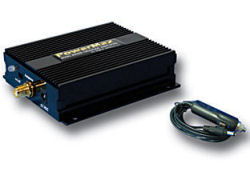Buying An Amplifier
While to many the appeal of boating
lies in the notion of “getting away from it all” there may be times when you must
stay connected to the world for the sake of practicality. In this week’s segment
from the Active Captain series, we conclude the quest for getting the strongest
cell signal while on your boat. Karen and Jeffrey Siegel give us the lowdown on
the necessary equipment and how it should be installed for maximum impact.

|
| An amplifier, if properly installed, can boost signal strength. |
BUYING AN AMPLIFIER
How do you know which amplifier will work with your phone and carrier? Most suppliers
make this fairly easy. They allow you to select the amplifier by cellular provider
or by the specific make and model of your phone. In general, you should select a
multi-band amplifier to give you the most options and flexibility in the future.
The next question is whether to use a "direct connection" amplifier or a "wireless"
amplifier. A direct connection amplifier requires a cable between the amplifier
and your mobile phone. A wireless connection amplifier re-broadcasts the signal
and can allow multiple phones to access the amplifier from almost anywhere on your
boat. While the wireless solution certainly sounds like the winner, on most boats
they will not work properly.
A wireless amplifier has an inside and an outside antenna. The inside antenna grabs
the signal from your mobile phone, amplifies it, and re-broadcasts it over the external
antenna. The problem in many boats - pretty much any boat under 100 feet - is that
the inside antenna will end up too close to the external antenna, or not isolated
enough. This causes feedback between the two antennas.
Direct Connection
For most boats a direct connection is the only alternative. The best way to connect
the phone is with an antenna jack on the phone. Many phones do not have an antenna
jack, though higher-end phones generally do. If the phone doesn't have a jack, there
are cradles that can be used. If you have the choice, a jack is better and should
be a consideration in selecting a mobile phone for your boat.

|
| Cradles can connect a phone to an amplifier, but direct connection is better. |
With a direct connection amplifier to your mobile phone, it is possible to connect
your laptop "wirelessly" to the Internet or even talk wirelessly. Your mobile phone
is directly connected to the amplifier and communicates to your laptop via Bluetooth
or WiFi.
AVOIDING 'LINE LOSS'
When selecting the antenna, we urge you to consider only marine grade equipment,
especially if you do your boating in saltwater conditions. Non-marine antennas will
quickly degrade in the typical marine environment. Another potential problem is
line loss. Some of you may have tried adding a simple antenna alone (without an
amplifier) and saw no increase in signal strength. Some may even have seen signal
strength decline.
When a signal passes through a cable, there will always be a reduction in the strength
of the signal. This is known as line loss, or attenuation. The greater the distance
traveled, the more signal will be lost.
This loss is also increased by using poor quality cable. When wiring up the amplifier
to the antenna, we suggest using LMR-400 type coaxial cable. This cable provides
the lowest line loss and is very easy to find. It is also fairly stiff and difficult
to work with, so plan for this in your installation.
Our last piece of advice about cabling is to have as few connectors involved as
possible. Each connector will cause additional line loss, so a straight cable from
your antenna to the amplifier is better than one that has a connector in-between.
Make the cabling simple between the amp and the antenna.
The way to remedy the line loss problem is by installing that amplifier we discussed,
before the external antenna. Amplifiers are allowed to increase the small 0.3 watt
mobile phone signal to a whopping 3 watts of signal output - 10 times what the phone
itself can put out.

|
| LMR-400 coaxial cable is recommended to cut line loss. |
Check out Activecaptain.com
and see how much fun cruising can be…
Copyright 2008 Karen and Jeffrey Siegel